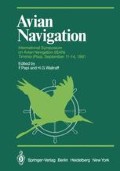Abstract
Various functions have been proposed for the avian eye pecten, including that of being a magnetic sensor useful during orientation. We examined the ultrastructure and chemical composition of pectens from Ring-billed Gulls and the chemical constituents of pigeon pectens to ascertain whether or not this structure is likely to function in such a capacity. Examination of the ultrastructure revealed several interesting features but none likely to be associated with a sensitivity to geomagnetic stimuli. Pigment granules abound in the pecten, particularly in the bridge portion, and we suspected that these might include magnetite or other ferrous material. By using a scanning electron microscope equipped with a KEVEX energy-dispersive electron microprobe X-ray analyzer, we found this not to be the case. The absence of magnetite and nervous tissue seems to rule out the possibility of the avian eye pecten being the location for the magnetic sensor of birds.
Access this chapter
Tax calculation will be finalised at checkout
Purchases are for personal use only
Preview
Unable to display preview. Download preview PDF.
References
Danilov V, Demirochaglyan G, Avetysan Z, Aelakhnyerdyan M, Grigoryan S, Saribekhyan G (1970) Possible mechanisms of magnetic sensitivity in birds (in Russian). Biol Zh Arm 23: 2634
Duke-Elder WS (1958) System of ophthalmology, vol I. The eye in evolution. Kimpton, London
Gould JL, Kirschvink JL, Deffeyes KS (1978) Bees have magnetic remanence. Science 201:1026–1028
Hanzely L, Southern WE, Molsen D (1975) Ultrastructure of the Ring-billed Gull eye pecten. Cytobios 12: 191–201
Kauth H, Somner H (1953) Das Ferment Kohlensaureanhydratase im Tierkörper, vol IV. Über die Funktion des Pecten im Vogelauge. Biol Zentralbl 72: 196–209
Pettigrew JD (1978) A role for the avian pecten oculi in orientation of the sun? In: Schmidt-Koenig K, Keeton WT (eds) Animal migration, navigation, and homing. Springer, Berlin Heidelberg New York, pp 42–54
Pumphrey RI (1961) Sensory organs: vision. In: Marshall Ai (ed) Biology and comparative physiology of birds, vol II. Academic Press, London New York, pp 55–68
Southern WE (1969) Orientation behavior of Ring-billed Gull chicks and fledgings. Condor 71: 418–425
Southern WE (1972) Magnets disrupt the orientation of juvenile Ring-billed Gulls. BioScience 22: 476–479
Southern WE (1975) Orientation of gull chicks exposed to project Sanguine’s electronmagnetic field. Science 189: 143–145
Southern WE (1976) Migrational orientation in Ring-billed Gull chicks. Auk 93: 78–85
Southern WE (1978) Orientation responses of Ring-billed Gull chicks: a re-evaluation. In: Schmidt-Koenig K, Keeton WT (eds) Animal migration, navigation, and homing. Springer, Berlin Heidel-berg New York, pp 311–317
Walcott C, Gould JL, Kirschvink JL (1979) Pigeons have magnets. Science 205: 1027–1029
Walls GL (1942) The vertebrate eye and its adaptive radiation. Cranbrook Inst Sci, Bloomfield Hills, Michigan
Wingstrand KG, Munk 0 (1965) The pecten oculi of the pigeon with particular regard to its function. Biol Skr Vid Selsk 14: 1–64
Wood CA (1917) The fundus oculi of birds, especially as viewed with the ophthalmoscope. Lakeside Press, Chicago
Author information
Authors and Affiliations
Editor information
Editors and Affiliations
Rights and permissions
Copyright information
© 1982 Springer-Verlag Berlin Heidelberg
About this paper
Cite this paper
Southern, W.E., Hanzely, L., Bailey, R.L., Molsen, D.V. (1982). Is the Avian Eye Pecten a Magnetic Sensor?. In: Papi, F., Wallraff, H.G. (eds) Avian Navigation. Proceedings in Life Sciences. Springer, Berlin, Heidelberg. https://doi.org/10.1007/978-3-642-68616-0_36
Download citation
DOI: https://doi.org/10.1007/978-3-642-68616-0_36
Publisher Name: Springer, Berlin, Heidelberg
Print ISBN: 978-3-642-68618-4
Online ISBN: 978-3-642-68616-0
eBook Packages: Springer Book Archive

